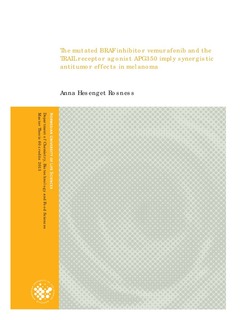| dc.description.abstract | Malignant melanoma is one of the most devastating cancer types with aggressive metastasizing abilities and the capability to develop therapy resistance. Until recently, effective therapeutic options have been non-existing, but in 2011/2012 the mutated BRAF inhibitor vemurafenib/Zelboraf® was approved by the FDA and EU, showing improved overall survival compared to existing therapy. Unfortunately, the effects of the drug are short-lived and new strategies to overcome resistance are under intense investigation.
In the present work, combination therapy with vemurafenib and the TRAIL receptor agonist APG350 has been evaluated in 2D- and 3D-cultures of the melanoma cell lines Melmet 1 and Melmet 5. It was observed that combination of the two drugs induces synergistic effects compared to mono-therapy in both cell lines, but synergy was dependent on the culturing type and drug dose utilized. In Melmet 5, synergistic results were obtained in 2D-cultures, 3D-cultures and the PuMA-assay, although the latter
was not fully optimized at the time of study and the results are therefore not conclusive. In Melmet 1, most of the concentrations tested in 2D-cultures indicated antagonistic effects, while synergy was obtained in 3D cultures using the same concentrations. Western analysis of both cell lines showed
increased cleavage of caspase-9, caspase-3 and PARP as well as upregulation of Bim and downregulation of Mcl-1, suggesting enhanced activation of apoptotic pathways.
The melanoma cells’ disposition for metastasizing and therapy resistance do not solely arise from intrinsic properties of the cell but are linked to tumor interactions with the microenvironment (TME), e.g. stromal cells, soluble molecules and extracellular matrix components. Thus components of TME should be taken into account when screening for new therapies, and conditioned medium from WI-38 lung fibroblasts and co-cultures were used to evaluate the impact of TME-effects on drug response. WI-38 cells affected the melanoma cells response to therapy by inducing decreased effect of
vemurafenib and increased effect of APG350. The results also indicated that fibroblast secreted factors for the most part were responsible for the change in drug effect, but that direct cell-cell contact can contribute to change these effects.
Overall the results imply that combination therapy of APG350 and vemurafenib may be effective as a new therapeutic strategy for melanoma patients, but further studies on TME effects and validation of the results in additional cell lines and in "in vivo" models are needed. | no_NO |
